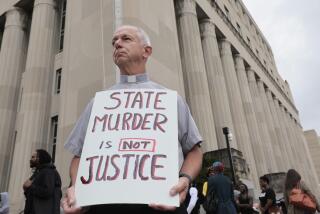The choreographers of death
- Share via
ONE OF LIFE’S most precious pleasures is detecting the stench of hypocrisy coming from people with whom we disagree. The taste of our own hypocrisy is bitter and shameful.
So it’s easy and reassuring for each side of the debate over whether doctors should assist in executions to accuse the other side of hypocrisy. Proponents eager to have doctors participate in killing people sentenced to death seem, in many cases, to want those same doctors to have nothing to do with assisted suicide or abortion -- a position their opponents see as baldly hypocritical. Meanwhile, those who oppose physicians aiding in capital punishment often don’t object to doctors becoming entwined with death in these other ways.
Who, if anyone, is the hypocrite? Or is the furor over doctors and the death penalty simply the most recent evidence of our culture’s confusion and ambivalence about physicians’ role in death?
Modern doctors have become choreographers of dying. For almost all of human history, the best a doctor could usually do was to be a companion and guide to the gates of death. But medical advances now require that explicit choices be made. The physician-choreographer has very little say about who will die -- but sometimes has a lot to do with how long the dance will last and whether death will be gruesome or dignified and graceful. American Hospital Assn. data show that at least 70% of all deaths in hospitals now involve decisions to limit treatment -- not to kill, but to remove ourselves and our machines so they no longer block the gateway.
So how are we to determine what behavior is moral? Those who want doctors never to hasten the deaths of dying persons or to end the life of fetuses, but who see nothing wrong with participating in the execution of a condemned criminal, say the crux of the issue is innocence. It is morally acceptable to be involved in the death of a convicted criminal but not a fetus or a dying person. This is not flatly hypocritical. But its apparent neatness is marred by frayed edges.
The first problem is that assisting suicide is not the same as killing an innocent. When doctors prescribe lethal drugs to their dying patients, they are two steps removed from pushing the patients through death’s gates.
The latest annual report on Oregon’s Death With Dignity law shows that many people who request such prescriptions never actually take the drugs; perhaps they merely needed assurance that they could end their lives should their suffering become unbearable. Some people value enormously the sense that they control their own fate and do not see why they should be sentenced to physical and moral agony as they die.
What’s more, it is not the doctor who administers the death-dealing dose; it is the patient.
The matter of innocence gets even murkier when it comes to abortion. Many doctors, like most Americans, have mixed feelings about abortion. They may worry that the fetus represents some form of innocent life, but they also understand that women, too, can be victims -- of abuse, violence, powerlessness, failed contraception or their own misjudgment. Parsing out degrees of innocence for them is a daunting project. How can we expect doctors to resolve an issue our society cannot?
Those who oppose doctors’ involvement in executions but support assisted suicide and access to abortion justify their position by saying they are exercising compassion for the dying person, the woman seeking an abortion or the condemned. And they’re fulfilling the physician’s commitment to do what is best for the patient, which may be the reassurance provided by a prescription for a quiet death, or an abortion for a desperate woman, but surely not an execution.
But death is sly. It eludes our feeble efforts at control and never forgives mistakes. Someone with many good days ahead may have a brief bout of depression and take the lethal dose of pills. And however we value women’s liberty to choose, we cannot wish away the medical destruction of developing life that is abortion. I have no illusions that we are going to “solve” death, or even reconcile within ourselves the inconsistencies that seethe within and divide our society so bitterly. Death is too wild for an easy truce. Doctors cannot disentangle themselves from our profound uneasiness with dying.
In 1994, Supreme Court Justice Harry Blackmun declared that “from this day forward, I no longer shall tinker with the machinery of death.” But judges don’t control the respirators, feeding tubes or resuscitation equipment; doctors do. We owe our physicians a clear-eyed acknowledgment that we feel many confusing, even contradictory, things about death. If the debate over doctors’ participation in California executions causes us to admit our irreconcilable inconsistencies, perhaps a more candid, less ideological conversation will yet be born.
More to Read
The biggest entertainment stories
Get our big stories about Hollywood, film, television, music, arts, culture and more right in your inbox as soon as they publish.
You may occasionally receive promotional content from the Los Angeles Times.










